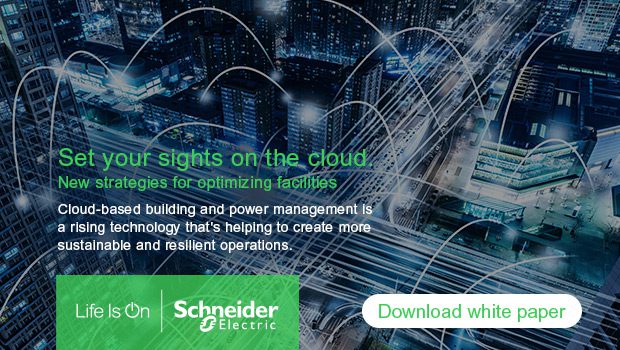Organizations in every sector – from education and government, to healthcare, hospitality, retail, and industrials – are increasingly recognizing that the performance of their buildings has a direct relationship with their overall operational performance. To meet the business goals of today and tomorrow requires making your facilities more sustainable, efficient, resilient, and people-focused.
The digitalization of electrical distribution and HVAC infrastructures has given facility teams the data, insights, and control needed to achieve these outcomes. But you may not have the budget needed for the required energy and power management (EPMS) and building management (BMS) software and computing hardware, or the people and expertise to take full advantage of them. This can be especially difficult if your team is managing a large portfolio of buildings. Fortunately, a new breed of cloud-based EPMS and BMS applications can help you meet this challenge.
Digitalize your buildings
EPMS and BMS apps turn ‘big data’ from networked IoT-enabled devices into actionable insights for better-informed decisions, more responsive facility teams, and more effective automated actions. These apps and others are also becoming more integrated, making it possible for you to address a range of operational goals, such as the ability to:
- Manage energy more effectively to improve efficiency, reduce costs, and comply with new standards.
- Use predictive maintenance to reduce costs and get more from your equipment.
- Adapt the workplace to changing needs, based on real usage and headcount.
- Improve building health using space management based on real-time data on occupancy, and HVAC control based on temperature, humidity, and air quality data.
- Increase resilience by getting early warning of risks to power distribution and HVAC, isolating root causes faster, and more.
- Use mobile access to personnel to perform building operations remotely, while improving efficiency and collaboration.
However, you may be continuing to face a manpower challenge as experienced people retire or your workforce is reduced. Your facility manager(s) may also be over-taxed with a growing number of responsibilities, including workplace safety. If you can hire new people, the new generation of less-experienced professionals will expect to have access to digital diagnostic tools. Finally, at a time when your organization is trying to find ways to cut operational costs, purchasing and maintaining EPMS and BMS systems at every site (including the necessary IT support) may simply not be affordable. You need a way to overcome these resource and budget constraints.
Take advantage of the cloud
Traditional onsite EPMS and BMS are highly connected systems, with many types of devices and equipment sending data to a central data server and software. For example, IoT-enabled smart meters, circuit breakers, and other energy assets connect to a power management application that provides facility-wide monitoring, analytics, and alarms. BMS sensors, meters, and controls, and systems connect to automation servers running automated control logic, logging, and alarming. In turn, these connect to an enterprise server that aggregates data and provides centralized configuration, control, and monitoring.
Cloud-hosted applications are becoming more common every day, from banking to e-commerce. Recent advances in the reliability of the Internet and cloud servers have made this possible. This is now extending to power and building management functions.
While critical and time-sensitive EPMS and BMS functionality should remain onsite to ensure the highest reliability and responsiveness (e.g. electrical protection, high-speed data collection, building control), less time-sensitive or non-critical EPMS and BMS functionality can be elevated to the cloud. This can include alarm management and analytics for non-critical sites, BMS global oversight (e.g. holiday schedules, global setpoints, etc.), and cloud-based data storage to simplify engagement with contracted services. For these functions, data is uploaded and shared over cyber-secure gateways.
Cut costs while increasing resiliency
Cloud-hosted EPMS and BMS means not having to host a computer, server, and software onsite. Cloud-hosted services are typically purchased on a monthly subscription basis, including the gateway, meaning the solutions become an OpEx cost instead of CapEx. With this model, you avoid the cost of onsite IT support. And being cloud-based, all applications are automatically kept updated and upgraded by the provider. Such platforms are typically very modular, making it easy to add on functionality or services.
A facility’s EPMS and BMS data is also safer in the cloud, thanks to the best-in-class cybersecurity of leading cloud providers. Your data will be offsite and automatically backed up, maximizing resilience. And you don’t have to worry about owning an aging computer that needs replacing, or software that hasn’t been updated with the latest cybersecurity patch. The secure connection to the cloud is constantly monitored for threats, with virus protection comprehensively managed.
Extend reach to every stakeholder and every building
With cloud-based apps, access to data is simplified, as there is no need for IT-supported VPN connections to onsite servers. IoT architectures also enable the easy use of mobile technologies, including 4G and 5G today, and low-power WAN technologies tomorrow.
A cloud platform offers much greater flexibility in terms of scalability. New building sites can be added on quickly and easily, creating a single enterprise-wide data repository with simple access to multiple facility views, building-to-building, performance comparisons, and more. In addition, a cloud-based solution offers simpler, centralized user management, including role-based access rights for C-level management, facility personnel, and contractors.
Connect to expert services
Once EPMS and BMS data and functionality are in the cloud, it opens the door to advisory services that you can take advantage of when your in-house resources are being stretched. Services combine cloud-based analytic tools with teams of experts that are experienced in both power and building management. This can help you offload some responsibilities, with flexible services that can match your needs and evolve with you.
For example, an advisory team can help with preventative maintenance by helping coordinate schedules and contractors for equipment servicing, or go beyond by using advanced analytics to support predictive condition-based maintenance that helps save costs and predicts failures to prevent downtime. 24/7 remote monitoring helps identify risks and finds opportunities to further reduce costs. Detailed audits and reporting will include all relevant key performance indicators that help flag and isolate equipment degradation, and support consultation on improvements and upgrades.
Engaging expert advisory services can be more cost-effective than employing on-site personnel for specialized tasks. The service provider augments your existing facility team, without the long-term commitment of having a permanent employee.
To learn more about this topic, refer to our white paper “Do more with less: Moving power and building management to the cloud.” Schneider Electric offers a range of cloud-based EcoStuxure Power and EcoStruxure Building applications and advisory services that are especially powerful for businesses that own or manage large portfolios of small and medium-sized facilities.




